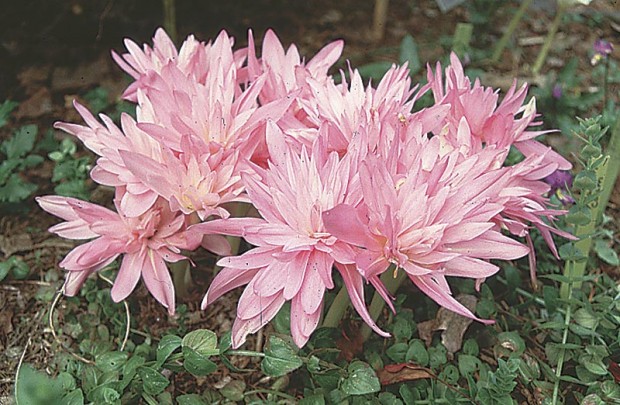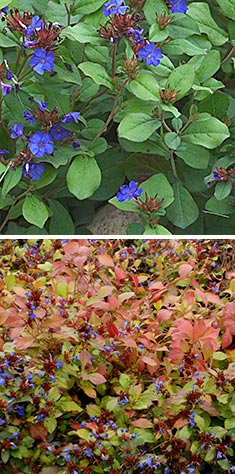
Gardeners looking to extend their garden’s blooming season far into the fall have a limited palette from which to choose. Fall pansies continue to grow in popularity and usually provide color until a hard freeze between Thanksgiving and Christmas. In a protected area these will often return the following spring and bloom until the heat of the summer knocks them out. For reliable October perennials, fall-blooming crocus or colchicum will do the trick. They come in a variety of colors ranging from rose, pink, violet, and white. Both produce chalice-shaped blossoms that poke through fallen leaves when you least expect them.
There are actually two types of these fall bloomers. It is very easy to confuse the autumn-flowering Crocus or “fall crocus” (a member of the iris family) with the Colchicum or “autumn crocus” (a member of the lily family) because of similarly shaped and colored flowers. Some differences, however, do exist.
Colchicum usually have layered blossoms on taller plants that flower a little later than autumn-flowering crocus. The other major difference is the price: fall-blooming crocus is much less expensive than colchicum.
Both types will produce green foliage in the spring that turns yellow by June. In fall, blooms appear without foliage, thus producing the nickname “naked boys” for colchicum. Crocus require a planting depth of 3 to 4 inches while colchicum prefer a 4 to 6 inch planting depth. Both prefer well-drained soil amended with bulb fertilizer, and both will tolerate full sun to partial shade. Both are reliable as naturalizers, which means they will return yearly without any fuss. Use groundcovers such as ivy, pachysandra, myrtle, or even your existing lawn to camouflage the spring foliage. This may also protect the bulb from getting damaged when, inevitably, its location is forgotten during the summer. Several colchicum varieties are readily available and will bloom this fall whether you plant them outside or not. These corms will even flower on a table without water or soil, and will survive as long as they are planted outside shortly thereafter.
All colchicum are poisonous, so squirrels are not likely to present a problem. Colchicum also makes an interesting and attractive cut flower because it doesn’t require water and stays fresh for days. The hybrid variety ‘Waterlily’ is 8 to 12 inches tall and has large, fully double, pink blooms in early to mid October. ‘Lilac Wonder’ has thinner petals and single pink blooms in early October. Other varieties exist but expect to pay more for rare ones such as the double white version.
Fall crocus (Crocus speciosus) are far more economical and therefore are perfect for mass plantings. The lavender-blue flowers open in the sun and close at night or during inclement weather. Although squirrels like these corms, other food is readily available in the fall during planting time. Once established, fall crocus divide into “cormlets” so easily that it would be almost impossible for animals to get every last one.
These 5- to 6-inch tall beauties are snow tolerant and naturalize exceptionally well. In addition to Crocus speciosus, with a little extra winter protection you can also try saffron crocus (Crocus sativus), from which the highly sought after saffron is harvested.
Use fall-blooming crocus or colchicum bulbs in perennial beds, rock gardens, or tucked beneath deciduous trees or shrubs. They are durable, long-lived, low maintenance wonders and a perfect way to end the garden’s flowering season.
George Papadelis is the owner of Telly’s Greenhouse in Troy and Shelby Township, MI.


